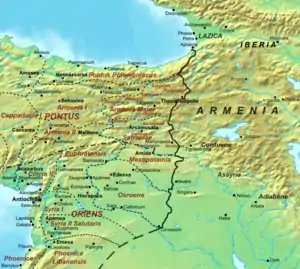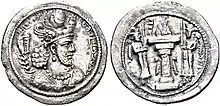Bahram IV
Bahram IV (also spelled Wahram IV or Warahran IV; Middle Persian: 𐭥𐭫𐭧𐭫𐭠𐭭), was the Sasanian King of Kings (shahanshah) of Iran from 388 to 399. He was the son and successor of Shapur III (r. 383–388).
| Bahram IV 𐭥𐭫𐭧𐭫𐭠𐭭 | |
|---|---|
| King of Kings of Iran and non-Iran[lower-alpha 2] | |
%252C_Herat_mint.jpg.webp) Coin of Bahram IV, minted at Herat | |
| King of the Sasanian Empire | |
| Reign | 388–399 |
| Predecessor | Shapur III |
| Successor | Yazdegerd I |
| Died | 399 |
| Issue | Khosrow |
| House | House of Sasan |
| Father | Shapur III |
| Religion | Zoroastrianism |
His reign was largely uneventful. In Armenia, he deposed his insubordinate vassal Khosrov IV and installed the latters brother Vramshapuh on the Armenian throne. In 395, the Huns invaded the countryside around the Euphrates and the Tigris, but were repelled.
Like his father, Bahram IV was killed by the nobility; he was succeeded by his brother Yazdegerd I.
Name
His theophoric name "Bahram" is the New Persian form of the Middle Persian Warahrān (also spelled Wahrām), which is derived from the Old Iranian Vṛθragna. The Avestan equivalent was Verethragna, the name of the old Iranian god of victory, whilst the Parthian version was Warθagn. The name is transliterated in Armenian as Vahagn/Vrām,[1] whilst the Greek transliteration is Baranes.[2]
Early life
According to the medieval historian al-Tabari (d. 923), Bahram was the son of Shapur II (r. 309–379), however, several other historians, such as Hamza al-Isfahani, states that he was the son of Shapur III (r. 383–388), which seems more likely.[3] Bahram, during the reign of his father, was the governor of the southeastern province of Kirman, where he built the town of Shiragan, which would serve as the capital of the province for the remainder of the Sasanian period.[4][5] The town played an important economic role, as it served as a mint city and had a great agricultural importance to the province.[6] According to the medieval geographer Yaqut (d. 1229), Bahram had buildings constructed in the city of Veh-Ardashir.[7] As many other governors of Kirman, Bahram bore the title of Kirmanshah (meaning "king of Kirman"), which would serve as the name of the city he later founded in western Iran.[8] A seal of Bahram has survived, made during his term as governor of Kirman. Written in Middle Persian, its inscription says the following; "Wahrān Kermān Šāh, son of the Mazdā-worshipping Lord Šāpūr, king of kings of Iran and non-Iran, who is a scion of lords".[3] In 388, Bahram succeeded his father, who had been killed by party of Iranian nobles.[9][3]
Reign

Armenia had been divided during the reign of Shapur III according to the terms of a peace treaty. But this arrangement barely survived the reign of Bahram IV. In 389, Khosrov IV, the vassal king of Armenia under Sasanian suzerainty grew wary of his subordination to Iran and entered into a treaty with the Roman emperor Theodosius I, who made him the king of a united Armenia in return for his allegiance.[3] This enraged Bahram IV and made him have Khosrov imprisoned in the Castle of Oblivion. Bahram IV shortly made the latter's brother Vramshapuh the new ruler of Armenia.[10]
In 395, the Huns invaded the Roman provinces of Sophene, Western Armenia, Mesopotamia, Syria, and Cappadocia. They reached as far Galatia, taking many captive. They then invaded the Iranian realm, devastating much of the countryside around the Euphrates and the Tigris. A counterattack was soon made, which resulted in the defeat of Hunnic forces and the retrieval of their spoils. Bahram IV allowed the Roman captives to stay at Veh-Ardashir and Ctesiphon, where they were given rations, which included bread, wine and oil.[11] Most of the captives were later returned to their own lands. These Hunnic invasions signaled to the Sasanians that the exposed areas in the natural defenses of Iran had to be strengthened.[12]
In 399, Bahram IV was killed by an arrow during a hunting expedition. The 9th-century historian Dinawari calls the incident an accident,[13] while al-Tabari calls the perpetators "a group of murderous evildoers".[4] Modern scholarship agree that the nobility was behind the murder.[14][15] A notable group of the nobility were the powerful Parthian noble families (known as the wuzurgan), who formed the bulk of the Iranian feudal army. Centered on the Iranian plateau, they were largely autonomous.[16] The shahanshah had noticeably little control over them; attempts to restrict their self-determination usually resulted in their murder (which included Shapur III and Bahram IV).[17] Ultimately, the Parthian nobility worked for the shahanshah for personal benefit, personal oath, and, conceivably, a common awareness of the "Aryan" (Iranian) kinship they shared with their Persian overlords.[16] Bahram IV was succeeded by his brother Yazdegerd I, who aware of the previous actions of the nobility, strived to restrict their power.[18]
Personality
The reception of medieval sources towards Bahram IV is mixed, although he is generally portrayed in a positive light.[19] According to al-Tabari "he governed his subjects in commendable fashion and was praised for his rule."[4] The 9th-century scholar Ibn Qutaybah mentions "his pursuit of justice and good rule." Hamza al-Isfahani calls him a "proud but harsh ruler, who neglected his subjects."[20] The 12th-century historian Ibn al-Balkhi calls him a "self-absorbed king who never held mazalim."[21]
Coinage
On his coinage, Bahram IV is portrayed wearing the same crown as his predecessors Bahram II and Hormizd II, with the two wings being a reference to Verethragna. The wings are attached to a mural crown, which was a symbol of the supreme god in Zoroastrianism, Ahura Mazda.[22] Bahram IV was the first Sasanian monarch to combine two religious components on his crown. Afterwards such crowns became a common feature among the Sasanians.[23] It was also under him that the use of mint signatures became regular.[24] After the regularization of mint signatures, the eastern province of Abarshahr became the highest mint producer (19%) in the Iranian realm.[25] The increase of mints in the region was to keep up the expenditure of the large number of troops stationed there.[26]
Like Shapur II, Ardashir II and Shapur III, Bahram IV also minted unique gold coins in the Indian region of Sindh, which may have corresponded to the Sasanian province of Hind.[27] Under Bahram IV, mints were established in the cities of Gundeshapur and Susa in Khuzistan.[28] A mint was also established in the northwestern province of Adurbadagan to support the construction of the Caspian Gates to protect the Caucasus border against Hunnic incursions.[26][12] The modern historian Michael Bonner has suggested that the construction of these type of large scale fortifications were initiated from 363 under Shapur II.[29]
Seal
Besides the seal made during his tenure as Kirmanshah, another seal of Bahram IV has been found during his rule as shahanshah. The seal, currently located in the British Museum, portrays him with his characteristic crown. He is holding a javelin and standing on the body of an unknown fallen foe.[3][30] This fallen foe resembles the same figure portrayed on the rock relief of Ardashir II, which most likely depicted the Roman emperor Julian, who fell in battle against the Sasanians in 363.[31][30][32] It has been suggested that the figure on the seal may have been Julian as well, added by Bahram IV to emphasize his own legitimacy and ability through his supposed participation in the formers defeat.[30][32]
Notes
- Also spelled "King of Kings of Iranians and non-Iranians".
- Also spelled "King of Kings of Iranians and non-Iranians".
References
- Wiesehöfer 2018, pp. 193–194.
- Klíma 1988, pp. 514–522.
- Bosworth 1999, p. 69.
- Christensen 1993, p. 182.
- Brunner 1983, pp. 771–772.
- Badiyi 2020, p. 213.
- Brunner 1983, p. 767.
- Kia 2016, p. 236.
- Kia 2016, pp. 236–237.
- Greatrex & Lieu 2002, p. 17.
- Bonner 2020, p. 95.
- Bonner 2020, p. 102 (see note 37).
- Daryaee 2014, p. 157 (see note 106).
- McDonough 2013, p. 604 (see note 3).
- McDonough 2013, p. 604.
- McDonough 2013, p. 604 (see also note 3).
- Shahbazi 2005.
- Frye 1983, p. 13.
- Bosworth 1999, p. 69 (see note 186).
- Pourshariati 2008, p. 58.
- Schindel 2013, p. 830.
- Schindel 2013, pp. 830–831.
- Schindel 2013, p. 818.
- Howard-Johnston 2014, p. 165.
- Howard-Johnston 2014, p. 164.
- Schindel 2016, p. 127.
- Jalalipour 2015, pp. 12–13.
- Bonner 2020, p. 98.
- Edwell 2020, p. 234.
- Shahbazi 1986, pp. 380–381.
- Canepa 2009, p. 110.
Sources
- Badiyi, Bahram (2020). "Cities and Mint Centers Founded by the Sasanians". Ancient Iranian Numismatics: 203–233.
- Bonner, Michael (2020). The Last Empire of Iran. New York: Gorgias Press. pp. 1–406. ISBN 978-1463206161.
- Bosworth, C.E., ed. (1999). The History of al-Ṭabarī, Volume V: The Sāsānids, the Byzantines, the Lakhmids, and Yemen. SUNY Series in Near Eastern Studies. Albany, New York: State University of New York Press. ISBN 978-0-7914-4355-2.
- Brunner, Christopher (1983). "Geographical and Administrative divisions: Settlements and Economy". In Yarshater, Ehsan (ed.). The Cambridge History of Iran, Volume 3(2): The Seleucid, Parthian and Sasanian Periods. Cambridge: Cambridge University Press. pp. 747–778. ISBN 0-521-24693-8.
- Canepa, Matthew P. (2009). The Two Eyes of the Earth: Art and Ritual of Kingship Between Rome and Sasanian Iran. University of California Press. ISBN 978-0520257276.
- Christensen, Peter (1993). The Decline of Iranshahr: Irrigation and Environments in the History of the Middle East, 500 B.C. to A.D. 1500. Museum Tusculanum Press. pp. 1–351. ISBN 9788772892597.
- Daryaee, Touraj (2014). Sasanian Persia: The Rise and Fall of an Empire. I.B.Tauris. pp. 1–240. ISBN 978-0857716668.
- Edwell, Peter (2020). Rome and Persia at War: Imperial Competition and Contact, 193–363 CE. Routledge. pp. 1–282. ISBN 978-1472418173.
- Frye, R. N. (1983). "The political history of Iran under the Sasanians". In Yarshater, Ehsan (ed.). The Cambridge History of Iran, Volume 3(1): The Seleucid, Parthian and Sasanian Periods. Cambridge: Cambridge University Press. ISBN 0-521-20092-X.
- Greatrex, Geoffrey; Lieu, Samuel N. C. (2002). The Roman Eastern Frontier and the Persian Wars (Part II, 363–630 AD). New York, New York and London, United Kingdom: Routledge (Taylor & Francis). ISBN 0-415-14687-9.
- Howard-Johnston, James (2014). "The Sasanian state: the evidence of coinage and military construction". Journal of Ancient History. De Gruyter. 2 (2): 144–181. doi:10.1515/jah-2014-0032.
- Jalalipour, Saeid (2015). "The Arab Conquest of Persia: The Khūzistān Province before and after the Muslims Triumph" (PDF). Sasanika.
- Klíma, O. (1988). "Bahrām IV". Encyclopaedia Iranica, Vol. III, Fasc. 5. pp. 514–522.
- Kia, Mehrdad (2016). The Persian Empire: A Historical Encyclopedia [2 volumes]: A Historical Encyclopedia. ABC-CLIO. ISBN 978-1610693912.
- McDonough, Scott (2013). "Military and Society in Sasanian Iran". In Campbell, Brian; Tritle, Lawrence A. (eds.). The Oxford Handbook of Warfare in the Classical World. Oxford University Press. pp. 1–783. ISBN 9780195304657.
- Multiple authors (1988). "Bahrām". Encyclopaedia Iranica, Vol. III, Fasc. 5. pp. 514–522.
- Pourshariati, Parvaneh (2008). Decline and Fall of the Sasanian Empire: The Sasanian-Parthian Confederacy and the Arab Conquest of Iran. London and New York: I.B. Tauris. ISBN 978-1-84511-645-3.
- Schindel, Nikolaus (2013). "Sasanian Coinage". In Potts, Daniel T. (ed.). The Oxford Handbook of Ancient Iran. Oxford University Press. ISBN 978-0199733309.
- Schindel, Nikolaus (2016). "The Coinages of Paradan and Sind in the Context of Kushan and Kushano-Sasanian Numismatics". In Curtis, Vesta Sarkhosh; Pendleton, Elizabeth J.; Alram, Michael; Daryaee, Touraj (eds.). The Parthian and Early Sasanian Empires: Adaptation and Expansion. Oxbow Books. ISBN 9781785702082.
- Shahbazi, A. Shapur (1986). "Ardašīr II". Encyclopaedia Iranica, Vol. II, Fasc. 4. pp. 380–381.
- Shahbazi, A. Shapur (2005). "Sasanian dynasty". Encyclopaedia Iranica, Online Edition. Retrieved 22 February 2014.
- Wiesehöfer, Josef (2018). "Bahram I". In Nicholson, Oliver (ed.). The Oxford Dictionary of Late Antiquity. Oxford: Oxford University Press. ISBN 978-0-19-866277-8.CS1 maint: ref=harv (link)
Bahram IV | ||
| Preceded by Shapur III |
King of Kings of Iran and non-Iran 388–399 |
Succeeded by Yazdegerd I |
